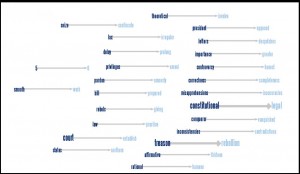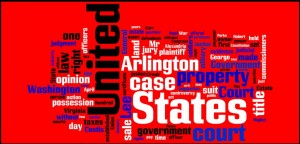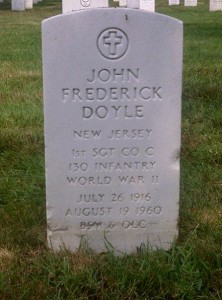As we come to the end of our fives weeks together I have gathered a wealth of information on the topic of Arlington National Cemetery, Robert E. Lee, and the Confiscation Acts of the Civil War. The conclusions that I have come to are outlined in my final project. A link to my final project can be found below:
The Dark History of Arlington National Cemetery
The historical argument presented in this project is as follows:
The Unjust Confiscation of the Arlington Estate
On May 24th 1861 Union troops took possession of 1,100 acres of land in Arlington Heights including a house sat high on a hill overlooking Washington, DC. That house was the ancestral home of Robert E. Lee and his wife Mary Anna Randolph Custis, as well as their seven children. The home had been built by George Washington Parke Custis, Robert E. Lee’s father in law in the early 1800s. Shortly after the Union seized this land, it became clear that the officials responsible had no intention of returning the property to the Lees at the end of the Civil War regardless of the outcome. The land was confiscated without trial or discussion thereby violating not only the Lee family’s right to due process of the law, but also the retainer clause of the United States Constitution.
152 years later it remains obvious, even to the most casual observer, why the Union would covet the expansive Arlington Heights property. While the landscape may have changed a little, the house still holds dominion over the bustling capital city of Washington, DC. General Winfeild Scott would have seen the land as a perfect location to implement an active defense strategy for the protection of the seat of the Union government. He ordered that the land be seized and fortified, for the protection of the Capital. Any logical war strategist would have agreed with the decision, seeing the potential damage that the enemy Confederate army would likely cause if they were to seize the land overlooking their adversaries. One well placed cannon ball from high on that hill could have changed the entire course of the war. To the general this was simply an act of wartime authority, and there was no question of legality. The land belonged to not only a known rebel, but also a general of the Confederate Army. The Lee family, most likely anticipating such an act by the Union, had already abandoned their family home and joined General Lee behind the Confederate lines. That being said, the Lee family anticipated returning to their family home upon the end of the war.
Any hopes that the Lee family had of returning to their ancestral home would be dashed by the actions of the Union government. While the United States had already passed a law regarding the confiscation of property belonging to known rebels, the act was only enforceable in Northern territory.The government sought to confiscate property within the boundaries of the Confederate States of America, including the incredibly valuable land in the Arlington Heights. In order to pursue that goal, the Congress of the United States passed a law entitled, An Act for the Collection of Direct Taxes in the Insurrectionary Districts within the United States by which the government levied and then collected taxes on real estate with the power to sell such real estate in the event of unpaid taxes. While on the surface the act seems like a simple tax law that was completely just, upon further inspection of its enforcement the laws true ulterior motive. The tax commissioners who were charged with the responsibility of collecting taxes from rebel land owners made the process as difficult as possible by refusing to accept payment from anyone other than the title holders of each piece of property, knowing full well that the majority of said title holders were the men of the family and subsequently off fighting for the Confederate army.
It was through these practices that the Union government obtained official ownership of the Arlington Estate. While Mary Lee fought the tax collectors as for as long as she could, she would eventually lose possession of the family home that meant so much to her. With Robert E. Lee and all three of their sons away at war, Mary Lee had no way to pay for her tax debts which amounted to a total of $92.57. In a last desperate attempt to retain ownership of the property, Mrs. Lee brought in a wealthy Uncle to pay her debts. The Union commissioned tax collector refused to accept payment from anyone other than General Robert E. Lee, who had no intention of abandoning his duties to the Confederate cause to pay money to the Union. To Mrs. Lee, this loss was worth far more than bricks and mortar; it was the loss of her childhood memories and the legacy of her father.
The confiscation of the Arlington Estate was point blank unjust, not only legally but also ethically and morally. First, there is the question of legality. The original Union legislation regarding confiscation of rebel property only barely passed into law on the 17th of July 1862. The law had undergone considerable redrafting from its original presentation to Congress on the 2nd of December 1861. Before its final passage, even President Lincoln considered the law to be Unconstitutional, due to the fact that it mercilessly stripped all rights from those deemed to be rebels or traitors without even the due process of the law. In his opinion is directly contradicted the retainer clause of the United States Constitution. When it was passed, the law still lacked a firm definition of the term rebel which made its enforcement speculative and up to the mercy of local governments. Its enforcement was also limited to the lands within the Union. When the Tax Collection Act was passed later, its enforcement was designed to exploit the war widows and families of Confederate soldiers for the benefit of the Union. Then there is the question of ethics, The Arlington Estate had been the home of Mary Lee and her family for generations. It was built through the hard work of her father and stood as a monument to her great great grandfather, George Washington. She had married Robert E. Lee there and they had raised 7 children in the home. The estate was the property of the Lee family, but it held far greater sentimental value to Mary Lee than ever could have been paid for. Despite this, the Union government went to great lengths to deprive her of her family home, even denying her the right to claim it as her final resting place although it has served as a burial site for 400,000 soldiers since.



